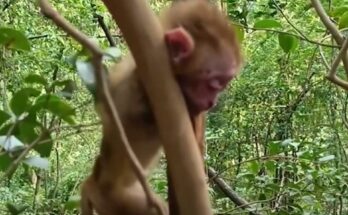In the wild, survival is a daily battle, and for a mother monkey nursing twin infants, the challenge is even greater. Unlike humans, who can rely on external support systems, mother monkeys must depend solely on their own bodies to nourish their young. When faced with the task of feeding two babies instead of one, the struggle to produce enough milk becomes a life-or-death situation.
Monkeys, like most mammals, have evolved to care for their offspring with instinctive dedication. However, twin births are rare and often put a strain on the mother’s resources. Producing milk requires significant energy, and when there are two hungry mouths to feed, a mother may struggle to meet the nutritional needs of both babies. In some cases, one infant may become weaker if the stronger sibling monopolizes the milk supply. This competition can lead to malnourishment and, in extreme cases, the survival of only one twin.
The mother monkey’s body prioritizes milk production by drawing on her own fat and nutrient stores, but if food is scarce, she may become weak herself. Some monkey species, like macaques and langurs, rely on their social groups for support. Other females in the troop may help by carrying the babies or even allowing them to suckle if they have recently given birth. However, this cooperative behavior is not universal, leaving some mothers to fend entirely for themselves.
Despite the hardship, maternal instincts push these mothers to do everything they can to keep both babies alive. They groom, protect, and feed them as best they can. In the unforgiving world of the wild, a mother monkey’s struggle highlights both the beauty and brutality of nature’s design.


